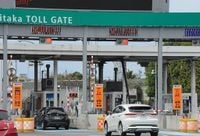A significant disruption to the Electronic Toll Collection (ETC) system in the NEXCO Central Japan area began around midnight on April 6, 2025, leading to severe traffic congestion across multiple expressways, including the Tomei and Chuo Expressways. The failure affected eight prefectures, causing frustration among drivers and prompting immediate responses from NEXCO Central Japan.
The malfunction was first reported at approximately 12:30 AM, with issues emerging at toll booths on the Tomei, Shin-Tomei, and Chuo Expressways. As the morning progressed, the extent of the problem widened, impacting around 50 toll booths and leading to the closure of some interchanges (ICs) by 10:00 AM and 12:30 PM. The disruption resulted in significant delays for commuters and travelers alike.
In response to the chaos, NEXCO Central Japan instructed drivers to continue through affected toll booths without making payment at the time. "Please pass through the toll booths experiencing issues as normal," the company stated, indicating that payment procedures would be requested at a later date. This approach is designed to alleviate immediate congestion while ensuring that drivers can complete their journeys without further delay.
At the Mitaka Main Line toll booth on the Chuo Expressway, a visit at 10:30 AM revealed that the significant traffic congestion caused by the ETC failure had subsided. While some ETC lanes remained closed, other lanes were opened to facilitate smoother traffic flow. Nevertheless, signs above the gates alternated between "ETC Only" and "Closed" messages, causing confusion for some drivers.
As of 2:00 PM on April 6, there was still no clear indication of when the ETC system would be fully operational again. NEXCO Central Japan urged motorists to check for updates on traffic conditions and to record their passage times and routes for reference, given the ongoing uncertainties surrounding the malfunction.
Meanwhile, the situation was compounded by a tragic incident in Nagasaki, where a medical transport helicopter overturned, resulting in the death of a female patient and the cardiopulmonary arrest of two medical personnel. This accident raised concerns about the safety protocols of the operating company, which had faced a fatal accident last year.
In another unrelated incident, a six-year-old boy, Rui Iwai, lost his life after falling from a forklift in Tsukuba City, Ibaraki Prefecture. The child's father, who was operating the forklift at the time, has been arrested on the scene. These incidents added to the day's grim news, overshadowing the ongoing traffic issues caused by the ETC failure.
As the day unfolded, NEXCO Central Japan continued to face challenges in managing the fallout from the ETC system failure. With the malfunction affecting a wide area and causing delays for thousands of drivers, the company’s reputation and operational protocols may come under scrutiny in the days to come.
Drivers are advised to stay informed about the status of the ETC system and to remain patient as the situation develops. With the potential for further complications, including new malfunctions in other areas, it is essential for travelers to remain vigilant and prepared for unexpected delays.
In summary, the large-scale ETC system failure has created significant challenges for NEXCO Central Japan, leading to congestion across major expressways and prompting a response that allows drivers to pass through toll booths without immediate payment. As investigations continue into the cause of the malfunction, the company is working to restore normal operations while addressing the needs of affected motorists.




